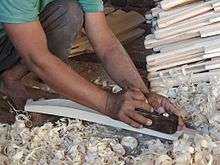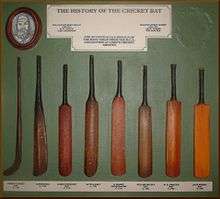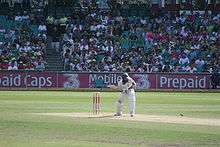Cricket bat

A cricket bat is a specialised piece of equipment used by batsmen in the sport of cricket to hit the ball, typically consisting of a cane handle attached to a flat-fronted willow-wood blade. The length of the bat may be no more than 38 inches (965 mm) and the width no more than 4.25 inches (108 mm). Its use is first mentioned in 1624.
Construction
.jpg)
The blade of a cricket bat is a wooden block that is generally flat on the striking face and with a ridge on the reverse (back) which concentrates wood in the middle where the ball is generally hit. The bat is traditionally made from willow wood, specifically from a variety of White Willow called Cricket Bat Willow (Salix alba var. caerulea), treated with raw (unboiled) linseed oil, which has a protective function. This variety of willow is used as it is very tough and shock-resistant, not being significantly dented nor splintering on the impact of a cricket ball at high speed, while also being light in weight. The face of the bat is often covered with a protective film by the user.
The blade is connected to a long cylindrical cane handle, similar to that of a mid-20th-century tennis racquet, by means of a splice. The handle is usually covered with a rubber grip. Bats incorporate a wooden spring design where the handle meets the blade. The current design of a cane handle spliced into a willow blade through a tapered splice was the invention in the 1880s of Charles Richardson, a pupil of Brunel and the first Chief Engineer of the Severn Railway Tunnel.[1][2] Spliced handles had been used before this but tended to break at the corner of the join. The taper provides a more gradual transfer of load from the bat's blade to the handle and avoids this problem.
The edges of the blade closest to the handle are known as the shoulders of the bat, and the bottom of the blade is known as the toe of the bat.
Bats were not always this shape. Before the 18th century bats tended to be shaped similarly to a modern hockey sticks. This may well have been a legacy of the game's reputed origins. Although the first forms of cricket are obscure, it may be that the game was first played using shepherd's crooks.

The bat generally recognised as the oldest bat still in existence is dated 1729 and is on display in the Sandham Room at The Oval in London.
Maintenance
When first purchased, most bats are not ready for immediate use and require knocking-in to allow the soft fibres to strike a hard new cricket ball without causing damage to the bat, and allowing full power to be transferred to the shot. Knocking-in involves striking the surface with an old cricket ball or a special mallet. This compacts the soft fibres within the bat and reduces the risk of the bat snapping. The bat may also need raw linseed oil, which fills in the gaps between the fibres.[3]
Sizes of bats
Law 6 of the Laws of Cricket,[4] as the rules of the game are known, state that the length of the bat may be no more than 38 in (965 mm) and the width no more than 4.25 in (108 mm). Bats typically weigh from 2 lb 7 oz to 3 lb (1.2 to 1.4 kg) though there is no standard. Appendix E of the Laws of Cricket set out more precise specifications.[5] This rule was introduced following the Monster Bat Incident of 1771.
Bats are available in a range of sizes, with some manufacturers offering unique variations. Commonly found are children's sizes 0 to 6, youth size Harrow and adult sizes. SH (Short Handle) is the most common adult size, whilst long handle and long blade options are also available. Children's sizes increase in length and width as the size increase. Although most adult bats will be the maximum width permitted (4.25 inches), no generally available cricket bat is the maximum length of 38 inches, indeed very few exceed 35 inches.
Variations

Various companies have over the years tried new shapes that come within the laws of the game to make a name for themselves and to improve sales. In the 1960s the first shoulderless bats appeared from Slazenger. This allowed more of the weight to be redistributed to the "sweet spot" of the blade providing more power to each stroke, whilst still having good balance and light "pick up." This style of bat was made famous by Lance Cairns's six sixes in a match played in 1983.
The 1970s saw double-sided bats from Warsop Stebbing. With the advent of Twenty-Twenty cricket, double-sided bats are experiencing renewed interest.
In 1974 the first GN100 Scoop was released; this was the first bat to turn shaping on its head by removing the wood from the centre of the rear of the bat. By removing this wood, the bat became lighter, its sweet spot grew and its pick up improved. Even though there is less material, strong strokes are still possible if well-timed. It allows weaker players to play many strokes they would otherwise omit from their repertoire.
This bat quickly became a big seller and various scooped bats such as the GN500, Dynadrive and Viper have been released by Gray Nicolls ever since, including a re-release of the Scoop itself for the 2012 English season. The removal of wood from the rear has been copied by many other companies without much critical acclaim.
In 1979 Australian cricketer Dennis Lillee briefly used a ComBat aluminium metal bat. After some discussion with the umpires, and after complaints by the English team that it was damaging the ball, which was later proved untrue, he was urged by the Australian captain Greg Chappell to revert to a wooden bat.[6] The rules of cricket were shortly thereafter amended, stating that the blade of a bat must be made entirely of wood.[4]
In 2005 Kookaburra released a new type of bat that had a Carbon fibre-reinforced polymer support down the spine of the bat. It was put on the bat to provide more support to the spine and blade of the bat, thus prolonging the life of the bat. The first player to use this new bat in international cricket was Australian Ricky Ponting. However this innovation in cricketing technology was controversially banned by the ICC[7] as they were advised by the MCC that it unfairly gave more power in the shot and was unfair in competition, as not all players had access to this new technology. But this was not taken lightly by Australian media as Ponting had scored plenty of runs since he started to use his new bat and English reporters had blamed this success on the new, 'unfair' piece of technology in his bat.
In 2005 Newbery created a carbon fibre handle, the C6 and C6+, which weighed 3 ounces/85 grams less than a standard laminated cane and rubber handle. It was used by Newbery and Puma for 3 years before the concept was copied by Gray Nicolls with a hollow plastic tube. However, this provoked the MCC to change the law on materials in handles amid fears that the new technology would lead to an increase in the distance the ball was hit. Now only 10% of the volume of the handle can be other than cane.
In 2008 Gray-Nicolls launched a bat with a second face on the base of the back of the bat. It was purely a marketing move as no paid players used the bat in competition.[8] In 2011 they also produced a bat with an offset handle position known as The Edge in what was also purely a marketing move.
Also in late 2008, SAFBats created a cricket bat with an offset edge, the edge offsetting allowed for an extended middle, better swing weight and increased performance without compromising the cricket bat's balance.[9] The production models were available in 2009, and the bat won awards in 2010 and 2012.[10]
Twenty20 bats
In 2004 Newbery created the Uzi, with a truncated blade and elongated handle for the new Twenty20 format of the game. This change allowed more wood to be placed in the middle, as more attacking shots are played in the shorter version of the game.
In 2009 an extreme version of the Newbery Uzi shape named the MMi3 was launched by Mongoose.[11] The design is unusual in that the blade is 33% shorter than a conventional bat and the handle is 43% longer.[12] Launched with a fanfare of publicity it proclaimed the idea of not defending the ball in the T20 format and purely playing attacking shots.
On 11 March 2010, Mongoose launched its range in India with the announcement of Matthew Hayden as the brand ambassador.[13] Stuart Law, the former Australian Test player, called it "a half-brick on a stick".[14] The bat was used by Anuraag in the 2010 version of the IPL. Gareth Andrew, the Worcestershire all-rounder, scored the maiden 100 with an MMi3 in professional cricket, when he hit 100 off 58 balls at the Oval in 2010 against Surrey.
In 2008 Lekka Cricket launched a T20 format bat, the Big Hitter. Black Cat Cricket then launched a T20 format bat, the Joker, in 2009. These worked on a similar principle to other T20 bats with the blade length reduced by one inch and an inch longer handle, but uniquely reduced the width of the bat to 4 inches in an adult bat.
Manufacturing
Modern bats are usually hand made in India or Pakistan due to the low cost of labour. However a few specialists in England, Australia, and New Zealand still make bats, mostly with use of a CNC lathe.
Cricket bat industry of India
Traditional Indian cricket bats are made in India, in the regions of Jammu and Kashmir, Punjab, Haryana, Gujarat, Uttar Pradesh and Rajasthan. In Kashmir it is made out of willow found in northern India, whereas trees like teak and saal wood are used in making these bats in north-western region of country. Some bats made in Kashmir are of international standards and are/were used by many national players in India such as Sunil Gavaskar, Virender Sehwag and Yuvraj Singh. Bats made in other regions are generally of lower quality, and mainly used in non-professional cricket games, such as tennis ball cricket, which are played in streets and neighbourhoods across India.
Kashmiri willow bats
The willow used in making these bats was brought in by the British, who ruled India, during the 1920s.[15] The industry, established in Kashmir, combines traditional tools with modern technology.
Kashmiri bats require constant knocking and oiling to make the bat good enough to use in a cricket match. Knocking makes the fibres of the willow blade compress together, which helps the bat bear the impact of the ball. Constant knocking for six hours is required so that the edges of the bat are well shaped. Another major aspect of taking care of such bats is oiling. Oil is applied on the back, toe, front and edges of the bat to make it more durable and to ensure the fibres get knitted properly. Some of the districts where these bats are made in Kashmir are Anantnag, Baramula, and Pahalgam.
Other areas and bats
Generally bats in other parts of country are made from the local wood found in the areas. One such establishment of bat-makers are from Gandhinagar, who migrate during the summer to different parts of the nation. They can even be seen selling the new mongoose cricket bats and are preferred by casual players of the game.[16]
See also
References
- ↑ "Severn Tunnel (1)". Track Topics, A GWR Book of Railway Engineering. Great Western Railway. 1971 [1935]. p. 179.
- ↑ Jones, Stephen K. (2009). Brunel in South Wales. III: Links with Leviathans. Stroud: The History Press. p. 56. ISBN 9780752449128.
- ↑ "Cricket equipment: Caring for your kit". BBC Sport. 26 August 2005. Retrieved 14 November 2010.
- 1 2 Lords.org – Marylebone Cricket Club (1 October 2008). "Law 6: Bats". Lords.org. Retrieved 15 November 2009.
- ↑ Lords.org – Marylebone Cricket Club. "Laws of Cricket Appendix E – The bat". Lords.org. Retrieved 15 November 2009.
- ↑ Brett, Oliver (11 April 2005). "Bat maker defends graphite innovation". BBC Sport. Retrieved 14 November 2010.
- ↑ "ICC and Kookaburra Agree to Withdrawal of Carbon Bat". NetComposites. 19 February 2006. Retrieved 31 December 2010.
- ↑ "Twenty20's latest swipe: a bat out of hell". Sydney Morning Herald. 13 November 2008. Retrieved 15 November 2009.
- ↑ "Handmade Cricket Bats – Handcrafted from English willow by SAFBats". Batscricket.com. Retrieved 26 October 2013.
- ↑ "Handmade Cricket Bats – Handcrafted from English willow by SAFBats". Safbats.co.uk. Retrieved 26 October 2013.
- ↑ "Cricket gets to grip with a new bat". BBC News. 22 May 2009. Retrieved 17 September 2009.
- ↑ Bull, Andy (27 May 2009). "Mongoose mayhem beastly for bowlers". London: guardian.co.uk. Retrieved 17 September 2009.
- ↑ "Hayden launches Mongoose bat". Zee News. Retrieved 26 October 2013.
- ↑ "Taking the long handle: could this bat really revolutionise cricket?". smh.com.au. 29 May 2009. Retrieved 20 March 2010.
- ↑ "Cricket Bats". Sgcricket.com. Retrieved 9 July 2012.
- ↑ Demand for mongoose bats high on IPL fever pitch